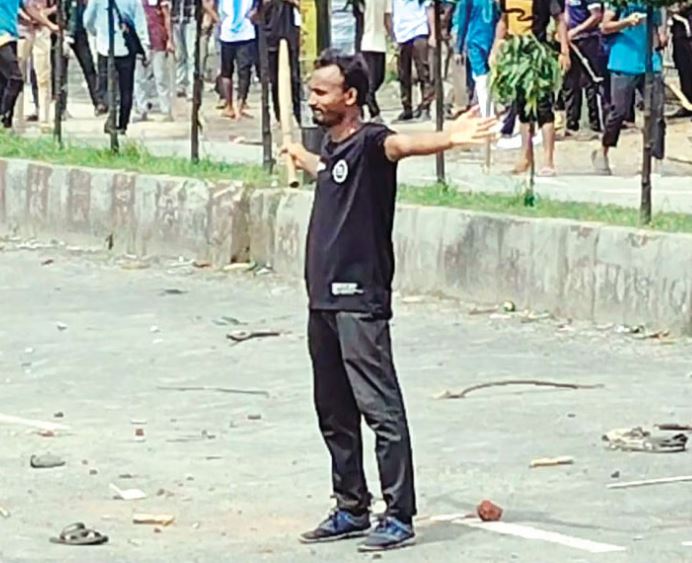The 2024 Bangladesh Quota Reform Movement refers to the protests and demands for changes to the public sector employment quota system in Bangladesh. This system reserves a significant percentage of government jobs for various groups, including women, indigenous people, people with disabilities, and descendants of freedom fighters. The movement is driven by students and young job seekers who believe the quota system is unfair and overly restrictive, limiting opportunities for meritorious candidates.
How many people died in the Bangladesh quota movement?
The 2024 Bangladesh Quota Reform Movement has unfortunately seen significant violence and loss of life. As of the most recent reports, at least 212 protesters ( Till July 25, 2024) have been killed during the protests. The violence has been widespread, involving clashes between protesters, the police, and members of the Chhatra League, a student wing of the ruling Awami League party.
The protests initially began peacefully but escalated after the government responded with heavy-handed measures, including deploying the army, imposing a nationwide curfew, and instituting an internet blackout. These actions aimed to quell the unrest but have led to further fatalities and injuries among protesters and security forces.
This movement has highlighted deep-rooted issues within the country, such as dissatisfaction with the quota system, high youth unemployment, and broader grievances against what is perceived as an authoritarian government.
What are Bangladesh quota protests?
Key Elements of the Bangladesh Quota Protests:
- Background:
- The quota system in Bangladesh has been in place for several decades, originally designed to support underrepresented groups in securing government jobs.
- The protests have roots in previous movements, such as the 2018 Bangladesh Quota Reform Movement, which saw significant student activism and temporary changes to the system.
- Demands:
- Protesters are calling for a reduction in the percentage of jobs reserved under quotas( currently 56% reserved).
- They advocate for a more merit-based recruitment process.
- Specific demands include the elimination or significant reduction of quotas for descendants of freedom fighters, which currently stand at 30%.
- Recent Developments:
- In 2024, a ruling by the Supreme Court of Bangladesh reinstated the 30% quota for descendants of freedom fighters, sparking renewed protests.
- The demonstrations began peacefully but escalated due to a heavy-handed government response, including clashes with police and the deployment of the military.
- Violence and Casualties:
- The protests have seen significant violence, with hundreds of deaths and thousands of injuries reported. Clashes between protesters, police, and members of the Chhatra League have been particularly deadly.
- The government’s response included imposing curfews, deploying the army, and instituting an internet blackout to control the situation.
- Impact and Broader Issues:
- The protests highlight broader issues in Bangladesh, such as high youth unemployment and dissatisfaction with the government’s handling of economic and democratic processes.
- The movement has gained international attention, with rights groups and the European Union expressing concern over the violence and loss of life.
What is the quota system in Bangladesh?
The quota system in Bangladesh is a government policy that reserves a 56% of public sector jobs for certain groups to ensure their representation in government employment. This system was established to promote inclusivity and support historically marginalized communities. The main categories benefiting from the quota system include:
Key Components of the Quota System:
- Freedom Fighters’ Descendants:
- 30% of government jobs are reserved for the children and grandchildren of freedom fighters of those who fought for Bangladesh’s independence in the 1971 Liberation War.
- This category has been a point of contention, as many argue that it unfairly benefits a specific group based on ancestry rather than merit.
- Women:
- 10% of jobs are reserved for women to promote gender equality and increase female participation in the workforce.
- District Quota
- 10 percent “zila quota” for “backward” districts.
- Indigenous People:
- 5% Jobs are reserved for indigenous communities to ensure their representation and support their socio-economic development.
- People with Disabilities:
- The system includes quotas of 1% for people with disabilities to provide them with equal employment opportunities.
- Other Minorities:
- There are also provisions for other marginalized and minority groups to promote diversity and inclusivity within the public sector.
Who is protesting against job quotas in Bangladesh?
Key Groups Involved in the Protests:
- University Students:
- Students from major universities in Dhaka, Chittagong, Rajshahi, and other cities have been at the forefront of the protests.
- Both public and private university students have participated, reflecting widespread dissatisfaction with the quota system.
- Young Job Seekers:
- Recent graduates and young professionals seeking government employment have also joined the protests.
- They argue that the current system disproportionately affects their chances of securing jobs based on merit.
- Student Organizations:
- Various student organizations have mobilized and coordinated the protests. While some of these groups are independent, others have affiliations with political parties.
- The Bangladesh General Students’ Rights Protection Council (BGSRPC) is one of the prominent groups leading the movement.
- Political Parties and Civil Society:
- Although the protests are primarily student-led, several political parties and civil society organizations have expressed support for the movement.
- The Bangladesh Nationalist Party (BNP) and other opposition groups have shown solidarity with the protesters, criticizing the government’s handling of the situation.
Students quota reform movement
Students from various schools, colleges, and private universities joined the protest. They protested and blocked roads in the quota reform movement, including Notre Dame College, Dhaka Residential Model College, RAJUK Uttara Model College, Adamjee Cantonment College, Viqarunnisa Noon School and College, Ideal School and College, Ideal College, Dhaka City College, BAF Shaheen College Dhaka, BAF Shaheen College Kurmitola, Birshrestha Noor Mohammad Public College, Birshrestha Munshi Abdur Rauf Public College, PrimeAsia University, United International University, BRAC University, University of Liberal Arts Bangladesh, Ahsanullah University of Science and Technology, Dania College, Dr. Mahbubur Rahman Mollah College, State University of Bangladesh, Enam Medical College and Hospital, Bangladesh University of Business and Technology, Daffodil International University, North South University, American International University Bangladesh, Independent University, Bangladesh, Eastern University, City University, East West University, Southeast University, International University of Business Agriculture and Technology, BGMEA University of Fashion and Technology, Manarat International University and many others.
Supreme Court verdict on Quota System on July 2024
Key Points of the Supreme Court Verdict:
- Reduction of Quotas:
- The Supreme Court ruled that 93% of government jobs should be allocated based on merit. The remaining 7% would be reserved for specific quotas: 5% for descendants of freedom fighters and 2% for other categories such as ethnic minorities and people with disabilities .
- Merit-Based Recruitment:
- The court emphasized the importance of merit-based recruitment, aiming to ensure that the majority of government positions are filled by the most qualified candidates regardless of their backgrounds .
- Impact on Protests:
- This decision came after weeks of student-led protests that turned deadly, with over 100 people killed and thousands injured during clashes with police. The violent unrest highlighted the deep dissatisfaction among young graduates facing an acute job crisis and concerns about the fairness of the quota system.
- Government’s Response:
- Following the verdict, the government issued a gazette notification to implement the new quota system as directed by the Supreme Court. The Law Minister stated that the new system would apply to all government, semi-government, and autonomous institution jobs. If no eligible candidates are available from a quota, positions will be filled based on merit .
- Curfews and Internet Blackouts:
- During the protests and leading up to the court’s decision, the government imposed curfews and suspended internet and text messaging services to control the situation and prevent further violence.
Huge damage of various Public and state properties
The 2024 Bangladesh Quota Reform Movement has resulted in extensive damage to state properties across the country. The violent clashes between protesters, security forces, and members of the ruling party’s student wing have led to widespread destruction.
Key Incidents of Damage:
- Educational Institutions:
- Universities and colleges have been major sites of conflict, with numerous reports of vandalism and destruction of campus facilities. Buildings, libraries, and administrative offices have been damaged during the protests .
- Public Infrastructure:
- Protesters have targeted various public infrastructure, including government buildings, police stations, and transport facilities. In some areas, vehicles were set on fire, and public transportation was disrupted due to the violence .
- Government Offices:
- Several government offices across different districts were attacked and ransacked. Office equipment and important documents were destroyed, further crippling administrative functions during the unrest .
- Public Transport:
- The protests led to significant damage to public transport systems. Buses and trains were particularly affected, with many vehicles being vandalized or set ablaze. The suspension of services such as the Maitree Express train between Dhaka and Kolkata indicates the extent of disruption .
- Commercial Properties:
- In addition to state properties, private commercial properties also suffered damage. Shops and businesses in protest-prone areas were looted and vandalized, causing substantial economic losses.
Government and Law Enforcement Response:
- Curfews and Security Measures:
- The government imposed strict curfews and deployed the military in major cities to control the situation. Despite these measures, sporadic clashes and vandalism continued, highlighting the challenges in maintaining law and order during such large-scale unrest.
- Investigation and Accountability:
- The government has announced investigations into the violence and the damage caused. Committees have been formed to assess the extent of the destruction and to hold those responsible accountable (The Business Standard).
The extensive damage to state and private properties during the 2024 Bangladesh Quota Reform Movement underscores the severe socio-political tensions in the country and the urgent need for addressing the underlying issues driving such unrest.
Protest Outside Bangladesh
Key Locations of Protests Outside Bangladesh:
- United States:
- Bangladeshi communities in major cities such as New York, Washington D.C., and Los Angeles have organized rallies and protests. These events often take place in front of Bangladeshi embassies or consulates to draw attention to the cause and call for international support.
- United Kingdom:
- In London, protests have been held near the Bangladeshi High Commission. The diaspora community, including students and professionals, has actively participated in these demonstrations to express solidarity with the protesters in Bangladesh.
- Canada:
- In cities like Toronto and Vancouver, Bangladeshi expatriates have organized protests and awareness campaigns. These events aim to highlight the violence and human rights abuses occurring in Bangladesh and to call for reforms to the quota system.
- Australia:
- Bangladeshi students and community members in cities such as Sydney and Melbourne have also held protests. These gatherings often involve speeches, placards, and peaceful marches to support the demands of the protesters back home.
- Europe:
- Protests have been reported in several European cities, including Paris, Berlin, and Rome. These demonstrations are part of a broader effort by the Bangladeshi diaspora to garner international attention and support for the movement.
Nature of the Protests:
- Solidarity Rallies:
- Many of these protests are organized as solidarity rallies, where participants express their support for the demands of the protesters in Bangladesh. They often call for an end to violence and a fairer, merit-based quota system.
- Awareness Campaigns:
- In addition to protests, various awareness campaigns have been launched to educate the international community about the situation in Bangladesh. This includes distributing leaflets, holding seminars, and utilizing social media platforms.
- Engagement with Local Governments:
- Protesters and community leaders often engage with local government officials and human rights organizations to raise concerns about the situation in Bangladesh and to seek their support in advocating for human rights and democratic reforms.
Impact:
- These international protests and solidarity movements help to amplify the voices of those protesting in Bangladesh, bringing global attention to their cause.
- They also aim to put pressure on the Bangladeshi government by showing that the concerns of the protesters have a global resonance and that there is widespread support for reforms.
The international solidarity movements demonstrate the global interconnectedness of the Bangladeshi community and the shared commitment to advocating for justice and fair treatment in their home country.
International condemn
The international community has widely condemned the violence and human rights abuses associated with the 2024 Bangladesh Quota Reform Movement. Several governments, international organizations, and human rights groups have issued statements calling for restraint and urging the Bangladeshi government to respect human rights and address the protesters’ demands.
Key International Reactions:
- United Nations:
- The UN has expressed deep concern over the violence and loss of life during the protests. The UN Secretary-General called for an immediate cessation of violence and urged the Bangladeshi authorities to ensure the protection of peaceful protesters and respect for human rights .
- European Union:
- The EU has issued a statement condemning the excessive use of force by security forces and calling for a thorough investigation into the deaths and injuries of protesters. The EU emphasized the importance of dialogue and peaceful resolution of the issues .
- United States:
- The US State Department has condemned the violence and called on the Bangladeshi government to respect the right to peaceful assembly and free expression. The US also urged the authorities to address the root causes of the protests and to engage in meaningful dialogue with the protesters .
- Amnesty International:
- Amnesty International has been vocal in its condemnation of the Bangladeshi government’s response to the protests. The organization has documented instances of police brutality and arbitrary arrests, calling for the immediate release of detained protesters and accountability for human rights violations .
- Human Rights Watch:
- Human Rights Watch has criticized the Bangladeshi authorities for their heavy-handed tactics and the imposition of curfews and internet blackouts. The organization has called for an end to the repression of peaceful dissent and for steps to ensure justice for the victims of state violence .
Impact and Calls for Action:
- Investigations and Accountability:
- International bodies have called for independent investigations into the deaths and injuries resulting from the protests. They demand accountability for those responsible for human rights abuses, including members of security forces and government officials .
- Dialogue and Reform:
- There is a strong call for the Bangladeshi government to engage in constructive dialogue with the protesters and to consider reforms to the quota system that balance historical commitments with the need for a merit-based system .
- Humanitarian Concerns:
- Concerns have also been raised about the humanitarian impact of the unrest, particularly on students and young people who have been disproportionately affected. International organizations are urging for measures to ensure their safety and well-being during this turbulent period .
The international condemnation underscores the global recognition of the serious human rights issues at stake and the need for the Bangladeshi government to address the protesters’ concerns in a manner that upholds democratic principles and human rights.
Country wide arrest by the police
Key Points on Nationwide Arrests:
- Scale of Arrests:
- Thousands of protesters have been arrested across Bangladesh since the beginning of the demonstrations. Reports indicate that over 5,500 individuals have been detained, including students, activists, and ordinary citizens caught up in the protests .
- Methods and Locations:
- Police have conducted raids in various parts of the country, including major cities like Dhaka, Chittagong, Rajshahi, and Sylhet. Educational institutions, student dormitories, and known gathering spots for protesters have been primary targets for these raids.
- Arrests have also taken place during clashes at protest sites, with police using tear gas, rubber bullets, and baton charges to disperse crowds and detain individuals .
- Legal and Human Rights Concerns:
- Human rights organizations have raised concerns about the arbitrary nature of many arrests and the conditions under which detainees are being held. There are reports of protesters being denied legal representation and facing harsh treatment while in custody .
- Amnesty International and Human Rights Watch have called for the immediate release of those arrested for peacefully protesting and demanded investigations into allegations of police brutality and abuse.
- Government and Police Statements:
- The Bangladeshi government has defended the arrests as necessary measures to restore order and prevent further violence. Officials have accused the protests of being infiltrated by opposition parties and other groups aiming to destabilize the country.
- The police have stated that they are acting within the law to maintain public safety and have pledged to investigate any reported abuses by their officers (DW).
- Public and International Reaction:
- The mass arrests have drawn condemnation from international bodies and governments, who have urged the Bangladeshi authorities to respect human rights and allow for peaceful protests. The international community has called for dialogue and reforms to address the underlying issues driving the unrest.
The nationwide arrests in response to the 2024 Bangladesh Quota Reform Movement reflect the government’s aggressive stance on the protests. The large number of detentions and reports of police misconduct have raised significant human rights concerns, prompting calls for accountability and reform from both domestic and international actors.




